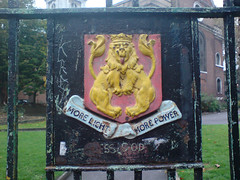 Saint Leonard's Church, Shoreditch.
Saint Leonard's Church, Shoreditch.One distinguished parishioner:
Thomas Fairchild (1667–1724), a pioneer gardener and the author of The City Gardener endowed an annual sermon at the church on either "The Wonderful World of God in the Creation" or "on the Certainty of the Resurrection of the Dead proved by Certain Change of the Animal and Vegetable Parts of the Creation." These Whitsun sermons become locally known as "The Vegetable Sermon" and continued into the 1990s.As befits a church that "was lit with gaslight in 1817, the first in London", it boasts a motto that reeks of Lucifer and the Illuminati:
... and in 2010
In a world with an adequate supply of Narrativium, I could report that St Leonard's was one of the six London churches built by Nicholas Hawksmoor:Sinclair argued that Hawksmoor's churches formed a pattern consistent with the forms of Theistic Satanism.Sadly, the actual architect is purportedly one George Dance, though this could just be a cover-up wrought by the conspiracy.
This idea was developed by Peter Ackroyd in his novel Hawksmoor (1985). In this, the historical Hawksmoor is refigured as the fictional Devil-worshiper Nicholas Dyer, while the eponymous Hawksmoor is cast as a twentieth-century detective charged with investigating a series of murders perpetrated on Dyer's (Hawksmoor's) churches. [...]
Both Sinclair and Ackroyd's ideas in turn were further developed by Alan Moore and Eddie Campbell in their graphic novel, From Hell, which speculated that Jack the Ripper used Hawksmoor's buildings as part of ritual magic, with his victims as human sacrifice. In the appendix, Moore revealed that he had met and spoke with Sinclair on numerous occasions while developing the core ideas of the book. The authors also brought notoriety to Hawksmoor's famous London churches. The argument includes the idea that, when dotted up on a map, the churches produce an Eye of Horus, and that this has some ritual significance.
 The origin of the mutant lion remains open to speculation.
The origin of the mutant lion remains open to speculation.




9 comments:
Don't worry, my pretties!
Our army of birds (and orbs) will get them.
P.S. How can one trust someone named Sinclair to give unbiased advise about Satan???
~
I really liked the Akroyd book but I like almost all of his writing.
WRONG. The Vegetable Sermon was by Michelle Obama.
More light, said Goethe on his deathbed.
The mutant lions? Siamese of course.
‘The existence of this creature is unknown to poets and mythology alike, but all of us, at one time or another, have come upon it, in the corner of a capital or the center of a frieze, and have felt a slight shudder of revulsion. Orthrus, the dog that guarded the cattle of the three-bodied Geryon (and that Hercules quickly dispatched), had two heads and one body; the T’ao T’ieh inverts this image, and is even more horrible, for its huge head is attached to one body on the right and another on the left. It generally has six legs, since its forelegs serve both bodies. Its head may be that of a dragon, a tiger, or a person; historians of art call it the “ogre-mask.” It is a monster of form, inspired by the devil of symmetry in the imagination of sculptors, potters, and ceramicists. Fourteen hundred years before the Christian era, during the Shang dynasty, it already figured on ritual bronzes.
‘”T’ao-T’ieh” means “glutton.” The Chinese paint it on porcelains in order to “warn against self-indulgence.”‘
...you made that up, gawn tell me you made that up.../shivers/
fjurba, another terrifying beast of deathness
I never make things up. Fictions -- like mirrors and fatherhood -- are abominable because they multiply and extend the visible universe.
...I trust you now, because of the fictions...
wauslam, sad Germanic high 5
Post a Comment